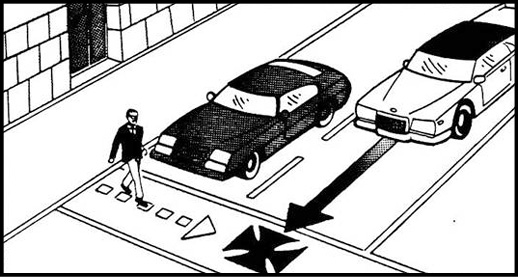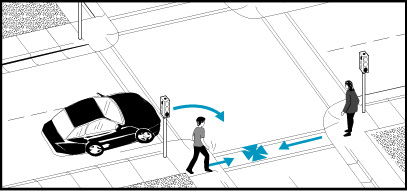Passing
How To Pass On A Two-Lane Road
- Wait for a passing zone to begin. A passing zone is indicated by striped lines to the right of the center line of the roadway. If the line nearest your vehicle is solid, you are not in a passing zone. Look ahead along the roadway to determine the length of the passing zone and if there is traffic approaching from the opposite direction. You must have sufficient time and space to execute your passing maneuver and return your vehicle completely to the right lane before the passing zone ends, before entering an intersection, and before oncoming traffic is within 200 feet of your vehicle;
- Before leaving your lane to begin passing, check your rear view and side mirrors, and turn your head and look back to check your “blind spot.” Be certain that no one is passing you;
- Activate your left turn signal as you begin passing;
- Pass on the left and do not return to the right lane until your vehicle is safely clear of the overtaken vehicle. Wait until you can see the car you have just passed in your rear view mirror;
- Activate your right turn signal before returning to the right lane. Be sure to turn your signal off once you have returned to the right lane.
Passing is prohibited on two-lane roads:
- In areas marked by a solid yellow line on the right of the center line, or a “Do Not Pass” sign, or double yellow lines;
- Within 100 feet of a railroad crossing;
- Within 100 feet of a bridge, viaduct or tunnel;
- When a car approaching from the opposite direction makes passing unsafe or will be within 200 feet of your vehicle prior to the completion of a passing maneuver;
- On a hill or curve where it is not possible to see oncoming vehicles which might be close enough to be a hazard;
- On the shoulder of the road;
- When a school bus is stopped to load or unload passengers.
Passing is Permitted When:
- Lawfully overtaking and passing another vehicle going in the same direction;
- An obstruction makes it necessary to drive to the left of the center line, but only after yielding to oncoming traffic;
- A roadway includes two or more marked lanes in the same direction;
- A roadway with more than one lane is restricted to one-way traffic. Upon a multi-lane, two way highway, you must never drive to the left of the center line except when authorized to do so by traffic control signals or signs or when making a left turn into an alley, private road or driveway.
Passing On The Right
You may pass on the right of another vehicle which is making or about to make a left turn if there is sufficient pavement width for both your vehicle and the vehicle making the left turn. You may also pass on the right when traveling on a multi-lane highway carrying two or more lanes of traffic in the same direction.
When Someone Passes You
When a driver behind you is overtaking your vehicle, be alert for any unsafe actions by the other driver. It is considered courteous to reduce your speed slightly, making it easier for the other vehicle to pass you. It is unlawful to increase your speed before you have been passed completely by the overtaking vehicle.
Passing Stopped Cars

Whenever any vehicle is stopped to permit a pedestrian to cross the roadway at a marked crosswalk or at any unmarked crosswalk at an intersection, the driver of any other vehicle approaching from the rear shall not overtake and pass the stopped vehicle. When stopping to allow a pedestrian to cross in front of you, leave sufficient room between your vehicle and the crosswalk so that approaching traffic can see the entirety of the crosswalk.
Slow down and prepare to stop if you are approaching an intersection where other vehicles are stopped, even though the traffic control devices indicate they are authorized to proceed. If they are stopped because they are allowing a pedestrian to cross the roadway, their vehicle may block your view of the pedestrian.
Passing Bicyclists
Bicyclists have the same rights and responsibilities on the road as motorists. Bicyclists are permitted to travel in the center of the traffic lane if there are safety hazards on the right side of the road (such as parked cars or debris) or if the lane is too narrow for a bicycle and a vehicle to share. Pass bicyclists with caution, treating them as you would any other vehicle and according to Georgia law. The law requires a driver to allow at least three feet between the driver and bicyclist when passing. If it is not safe to leave three feet of space, the driver should wait until it is safe to pass the bicyclist. Bicycle lanes are not passing lanes and should never be used to pass another motor vehicle.
Passing Motorcyclists
A motorcyclist legally occupies the full width of a single lane when traveling. When passing a motorcyclist, a driver must pass in an adjacent lane. Drivers are not permitted to occupy the same lane as a motorcyclist while passing them.
Weaving
It is unlawful to weave from one lane of traffic to another in order to move faster than the flow of traffic. A motorist may change lanes on a multi-lane highway and pass slower moving vehicles only when it is safe to do so. A driver’s signaling to change lanes should be clearly indicated so as to warn vehicles of the movement.
Turn Signals and Making Turns Safely
Turn movements by motor vehicles are regulated by law, and failure to observe or comply is a violation. Drivers must know and understand the law in order to turn safely and avoid crashes.
STOP

RIGHT TURN

LEFT TURN

A turn signal must be given whenever a turn is made to the right or the left. You must give a continuous turn signal for an adequate distance to alert other drivers before turning. Never decide to make a turn at the “last minute.” Turning quickly or erratically can be dangerous to you and other drivers.
Illegal Signals
It is against the law to flash turn signals as a courtesy or “do pass” signal to other drivers in the rear.
How To Make A Right Turn
- Using appropriate signals, and giving drivers ahead of and behind you adequate notice, activate your right turn signal;
- Approach the intersection in the right lane, staying as close as practicable to the curb or edge of the roadway;
- If there is a bicycle lane on the road on which you are traveling, you must yield to bicyclists traveling straight through the intersection before making a right turn;
- Make the turn in such a way as to end up in the right lane of the street into which you have turned and avoid entering any other lane of traffic. If there are multiple turning lanes on the street you are turning from, complete the turn so that your vehicle ends up in the corresponding lane on the street you are turning onto.
How To Make A Left Turn
- Using appropriate signals, and giving drivers ahead of and behind you adequate notice, activate your left turn signal;
- Move into the far left lane of the direction in which you are traveling, or into the turning lane if one is provided;
- Keep your wheels straight until you begin making the turn;
- Yield the right-of-way to all vehicles, including bicycles, which are approaching from the opposite direction, and pedestrians crossing either roadway;
- When safe to do so, and when traffic signals/signs permit, make your turn so that your vehicle ends up in the lane closest to the center lane(s) in your direction of traffic on the street you turned onto, or closest to the center line if there is no center lane;
- If there are multiple turning lanes on the street you are turning from, complete the turn so that your vehicle ends up in the corresponding lane on the street you are turning onto;
- Once you have entered an intersection to make a left turn, you cannot change lanes in the intersection;
- You must stop and remain stopped for any pedestrians in the crosswalk of the road you are turning onto until they have cleared the lanes of traffic that you are traveling on.
Watching for Pedestrians When Making Turns
At most intersections where there is a pedestrian signal, the “Walk” signal of the crossing street corresponds to the green light of the roadway you are traveling on. This means that when you are authorized to turn, pedestrians are authorized to cross the street onto which you are turning at the same time. Therefore, before making your turn, you must stop and remain stopped for any pedestrians in the crosswalk of the road onto which you wish to turn until they have cleared the lanes of traffic upon which you are traveling.

U-Turns
Do not make a U-turn on a curve or near the top of a hill if you cannot be seen by other drivers approaching from either direction. Do not make a U-turn where signs prohibit doing so.
Making Turns on Multi-Lane Highways
On a multi-lane, two-way highway, you must never drive to the left of the center line except when making a left turn. If traffic control signals or signs are present, you may only complete the turn when authorized to do so by the traffic control signals or signs. When making left turns, you must always yield to oncoming traffic, and wait for pedestrians to clear the lanes of traffic, driveway, sidewalk, or alley you are turning into.
Stopping, Standing, and Parking
It is against the law to park on a highway. If the vehicle is disabled, you should make every practical effort to park off the highway, leaving free passage and a clear view of your vehicle for 200 feet in each direction.
Stopping, Standing or Parking is not permitted under the following conditions at any time:
- On the street side of any parked vehicle;
- On a sidewalk;
- Within an intersection;
- On a crosswalk;
- Between a safety zone and the adjacent curb;
- Alongside or opposite any street excavation or obstruction when stopping, standing, or parking would obstruct traffic;
- Upon a bridge or overpass, or within a highway tunnel;
- On any railroad tracks;
- On a controlled access roadway;
- In the area between roadways on a divided highway, including crossovers;
- At any place marked by a no-parking sign.
Stopping, Standing or Parking is permitted only momentarily to pick up or drop off passengers under the following conditions:
- In front of a public or private driveway;
- Within 15 feet of a fire hydrant;
- Within 20 feet of a crosswalk at an intersection;
- Within 30 feet of a stop sign, yield sign, or traffic control signal;
- Within 20 feet of a fire station driveway;
- Within 75 feet of the spot across the street from a fire station driveway;
- Within 50 feet of a railroad crossing;
- At any place where official signs prohibit standing.
